Analysis of Racism, Power, and Difference in Contemporary Australia
VerifiedAdded on 2023/06/03
|8
|2609
|396
Report
AI Summary
This assignment presents a comprehensive analysis of racism in Australia, incorporating both online contributions and a critical reflection. The report delves into the theory of whiteness, examining how it provides privileged treatment to certain groups and its impact on the Australian education sector. It explores the concept of sophisticated racism and the evolving social norms of acceptance within Australian society. The analysis includes an overview of online discussions, uncovering key issues, contradictions, and complexities related to whiteness theory, such as ethnocentrism and the historical context of racism against indigenous Australians. The report further examines the concepts of nation, power, and difference, highlighting how whiteness is critical to the creation of the Australian nation and its implications for indigenous residents. Finally, the assignment discusses the contribution to learning, providing insights into contemporary Australian society and the challenges faced by academics in addressing critical whiteness theory. The assignment adheres to the provided brief, including online contributions and a critical review.
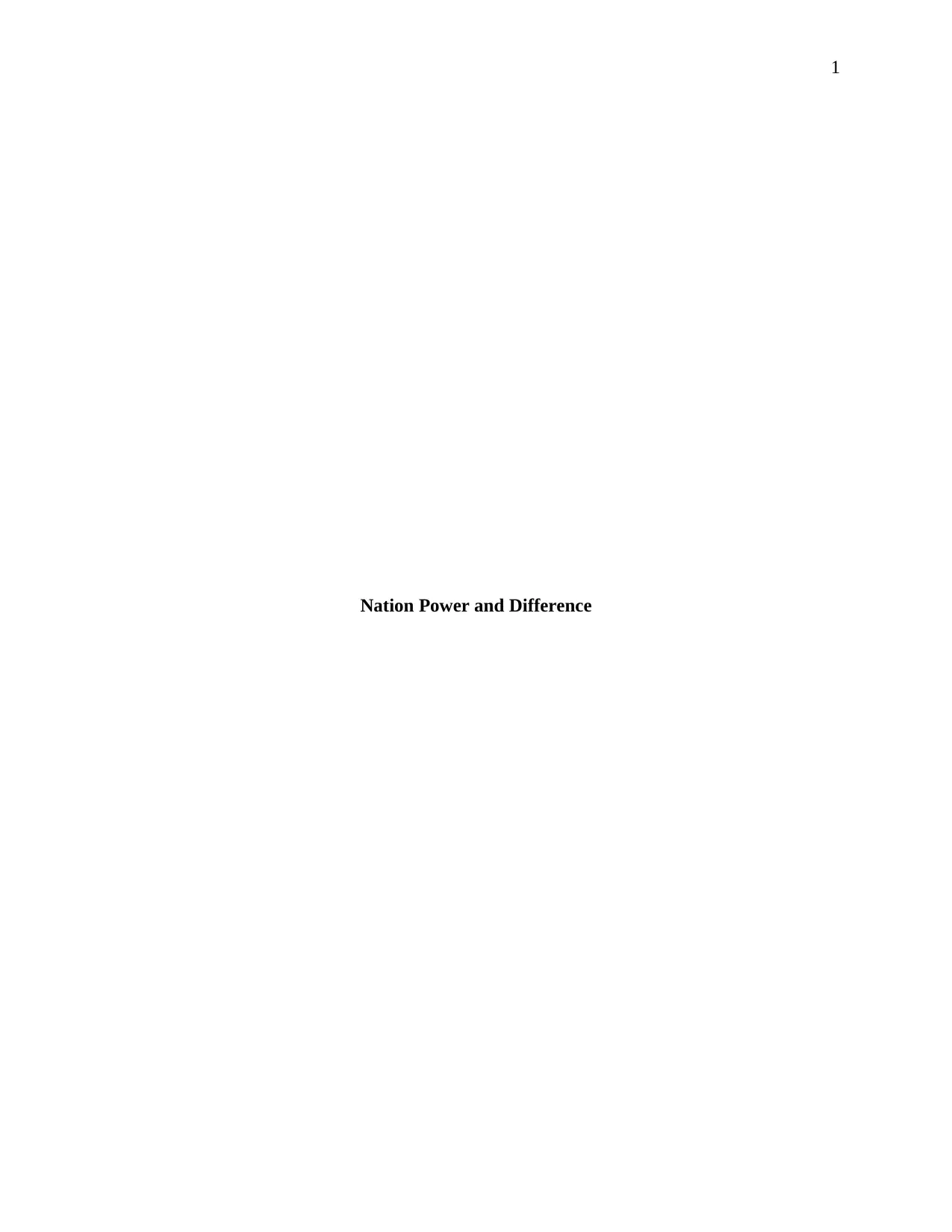
1
Nation Power and Difference
Nation Power and Difference
Paraphrase This Document
Need a fresh take? Get an instant paraphrase of this document with our AI Paraphraser
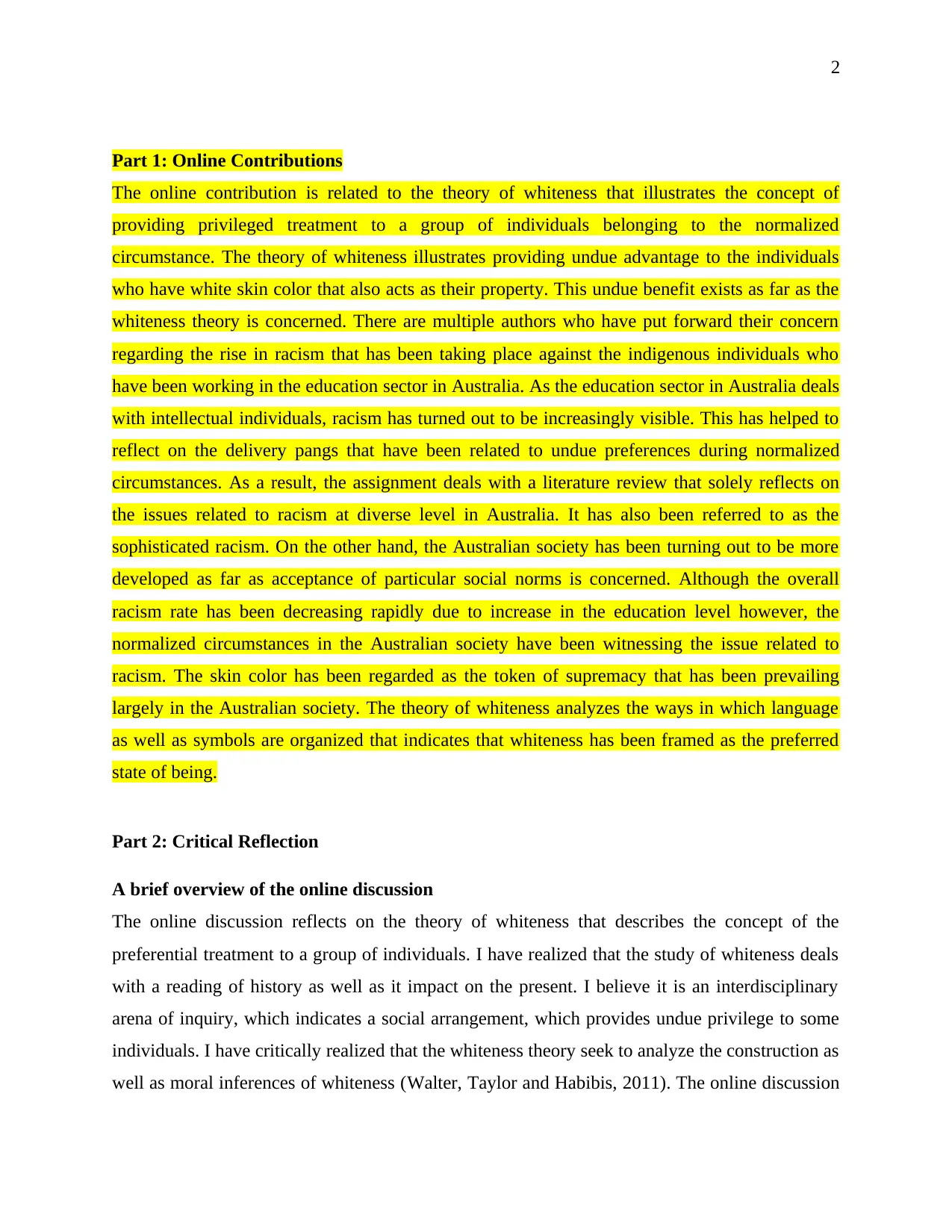
2
Part 1: Online Contributions
The online contribution is related to the theory of whiteness that illustrates the concept of
providing privileged treatment to a group of individuals belonging to the normalized
circumstance. The theory of whiteness illustrates providing undue advantage to the individuals
who have white skin color that also acts as their property. This undue benefit exists as far as the
whiteness theory is concerned. There are multiple authors who have put forward their concern
regarding the rise in racism that has been taking place against the indigenous individuals who
have been working in the education sector in Australia. As the education sector in Australia deals
with intellectual individuals, racism has turned out to be increasingly visible. This has helped to
reflect on the delivery pangs that have been related to undue preferences during normalized
circumstances. As a result, the assignment deals with a literature review that solely reflects on
the issues related to racism at diverse level in Australia. It has also been referred to as the
sophisticated racism. On the other hand, the Australian society has been turning out to be more
developed as far as acceptance of particular social norms is concerned. Although the overall
racism rate has been decreasing rapidly due to increase in the education level however, the
normalized circumstances in the Australian society have been witnessing the issue related to
racism. The skin color has been regarded as the token of supremacy that has been prevailing
largely in the Australian society. The theory of whiteness analyzes the ways in which language
as well as symbols are organized that indicates that whiteness has been framed as the preferred
state of being.
Part 2: Critical Reflection
A brief overview of the online discussion
The online discussion reflects on the theory of whiteness that describes the concept of the
preferential treatment to a group of individuals. I have realized that the study of whiteness deals
with a reading of history as well as it impact on the present. I believe it is an interdisciplinary
arena of inquiry, which indicates a social arrangement, which provides undue privilege to some
individuals. I have critically realized that the whiteness theory seek to analyze the construction as
well as moral inferences of whiteness (Walter, Taylor and Habibis, 2011). The online discussion
Part 1: Online Contributions
The online contribution is related to the theory of whiteness that illustrates the concept of
providing privileged treatment to a group of individuals belonging to the normalized
circumstance. The theory of whiteness illustrates providing undue advantage to the individuals
who have white skin color that also acts as their property. This undue benefit exists as far as the
whiteness theory is concerned. There are multiple authors who have put forward their concern
regarding the rise in racism that has been taking place against the indigenous individuals who
have been working in the education sector in Australia. As the education sector in Australia deals
with intellectual individuals, racism has turned out to be increasingly visible. This has helped to
reflect on the delivery pangs that have been related to undue preferences during normalized
circumstances. As a result, the assignment deals with a literature review that solely reflects on
the issues related to racism at diverse level in Australia. It has also been referred to as the
sophisticated racism. On the other hand, the Australian society has been turning out to be more
developed as far as acceptance of particular social norms is concerned. Although the overall
racism rate has been decreasing rapidly due to increase in the education level however, the
normalized circumstances in the Australian society have been witnessing the issue related to
racism. The skin color has been regarded as the token of supremacy that has been prevailing
largely in the Australian society. The theory of whiteness analyzes the ways in which language
as well as symbols are organized that indicates that whiteness has been framed as the preferred
state of being.
Part 2: Critical Reflection
A brief overview of the online discussion
The online discussion reflects on the theory of whiteness that describes the concept of the
preferential treatment to a group of individuals. I have realized that the study of whiteness deals
with a reading of history as well as it impact on the present. I believe it is an interdisciplinary
arena of inquiry, which indicates a social arrangement, which provides undue privilege to some
individuals. I have critically realized that the whiteness theory seek to analyze the construction as
well as moral inferences of whiteness (Walter, Taylor and Habibis, 2011). The online discussion
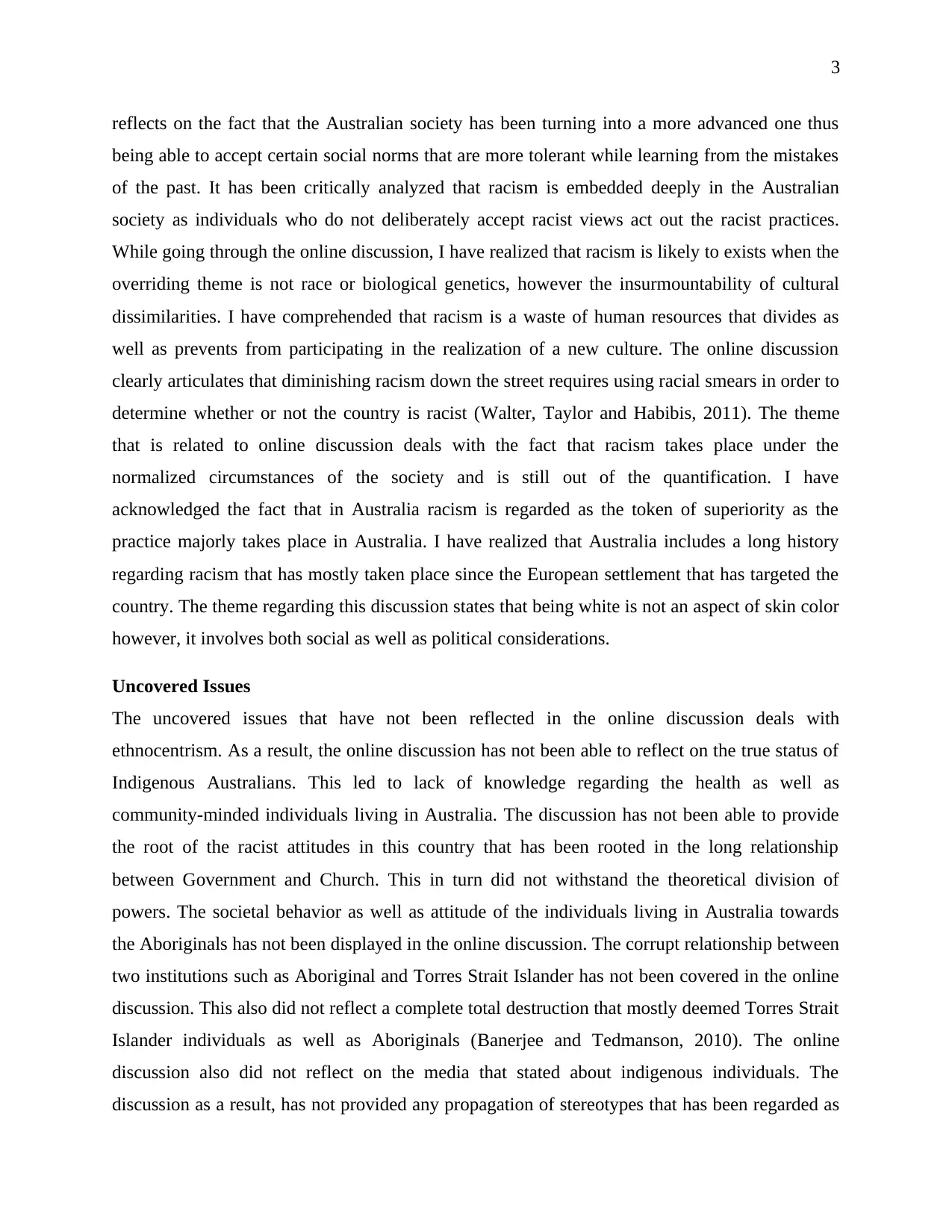
3
reflects on the fact that the Australian society has been turning into a more advanced one thus
being able to accept certain social norms that are more tolerant while learning from the mistakes
of the past. It has been critically analyzed that racism is embedded deeply in the Australian
society as individuals who do not deliberately accept racist views act out the racist practices.
While going through the online discussion, I have realized that racism is likely to exists when the
overriding theme is not race or biological genetics, however the insurmountability of cultural
dissimilarities. I have comprehended that racism is a waste of human resources that divides as
well as prevents from participating in the realization of a new culture. The online discussion
clearly articulates that diminishing racism down the street requires using racial smears in order to
determine whether or not the country is racist (Walter, Taylor and Habibis, 2011). The theme
that is related to online discussion deals with the fact that racism takes place under the
normalized circumstances of the society and is still out of the quantification. I have
acknowledged the fact that in Australia racism is regarded as the token of superiority as the
practice majorly takes place in Australia. I have realized that Australia includes a long history
regarding racism that has mostly taken place since the European settlement that has targeted the
country. The theme regarding this discussion states that being white is not an aspect of skin color
however, it involves both social as well as political considerations.
Uncovered Issues
The uncovered issues that have not been reflected in the online discussion deals with
ethnocentrism. As a result, the online discussion has not been able to reflect on the true status of
Indigenous Australians. This led to lack of knowledge regarding the health as well as
community-minded individuals living in Australia. The discussion has not been able to provide
the root of the racist attitudes in this country that has been rooted in the long relationship
between Government and Church. This in turn did not withstand the theoretical division of
powers. The societal behavior as well as attitude of the individuals living in Australia towards
the Aboriginals has not been displayed in the online discussion. The corrupt relationship between
two institutions such as Aboriginal and Torres Strait Islander has not been covered in the online
discussion. This also did not reflect a complete total destruction that mostly deemed Torres Strait
Islander individuals as well as Aboriginals (Banerjee and Tedmanson, 2010). The online
discussion also did not reflect on the media that stated about indigenous individuals. The
discussion as a result, has not provided any propagation of stereotypes that has been regarded as
reflects on the fact that the Australian society has been turning into a more advanced one thus
being able to accept certain social norms that are more tolerant while learning from the mistakes
of the past. It has been critically analyzed that racism is embedded deeply in the Australian
society as individuals who do not deliberately accept racist views act out the racist practices.
While going through the online discussion, I have realized that racism is likely to exists when the
overriding theme is not race or biological genetics, however the insurmountability of cultural
dissimilarities. I have comprehended that racism is a waste of human resources that divides as
well as prevents from participating in the realization of a new culture. The online discussion
clearly articulates that diminishing racism down the street requires using racial smears in order to
determine whether or not the country is racist (Walter, Taylor and Habibis, 2011). The theme
that is related to online discussion deals with the fact that racism takes place under the
normalized circumstances of the society and is still out of the quantification. I have
acknowledged the fact that in Australia racism is regarded as the token of superiority as the
practice majorly takes place in Australia. I have realized that Australia includes a long history
regarding racism that has mostly taken place since the European settlement that has targeted the
country. The theme regarding this discussion states that being white is not an aspect of skin color
however, it involves both social as well as political considerations.
Uncovered Issues
The uncovered issues that have not been reflected in the online discussion deals with
ethnocentrism. As a result, the online discussion has not been able to reflect on the true status of
Indigenous Australians. This led to lack of knowledge regarding the health as well as
community-minded individuals living in Australia. The discussion has not been able to provide
the root of the racist attitudes in this country that has been rooted in the long relationship
between Government and Church. This in turn did not withstand the theoretical division of
powers. The societal behavior as well as attitude of the individuals living in Australia towards
the Aboriginals has not been displayed in the online discussion. The corrupt relationship between
two institutions such as Aboriginal and Torres Strait Islander has not been covered in the online
discussion. This also did not reflect a complete total destruction that mostly deemed Torres Strait
Islander individuals as well as Aboriginals (Banerjee and Tedmanson, 2010). The online
discussion also did not reflect on the media that stated about indigenous individuals. The
discussion as a result, has not provided any propagation of stereotypes that has been regarded as
⊘ This is a preview!⊘
Do you want full access?
Subscribe today to unlock all pages.

Trusted by 1+ million students worldwide
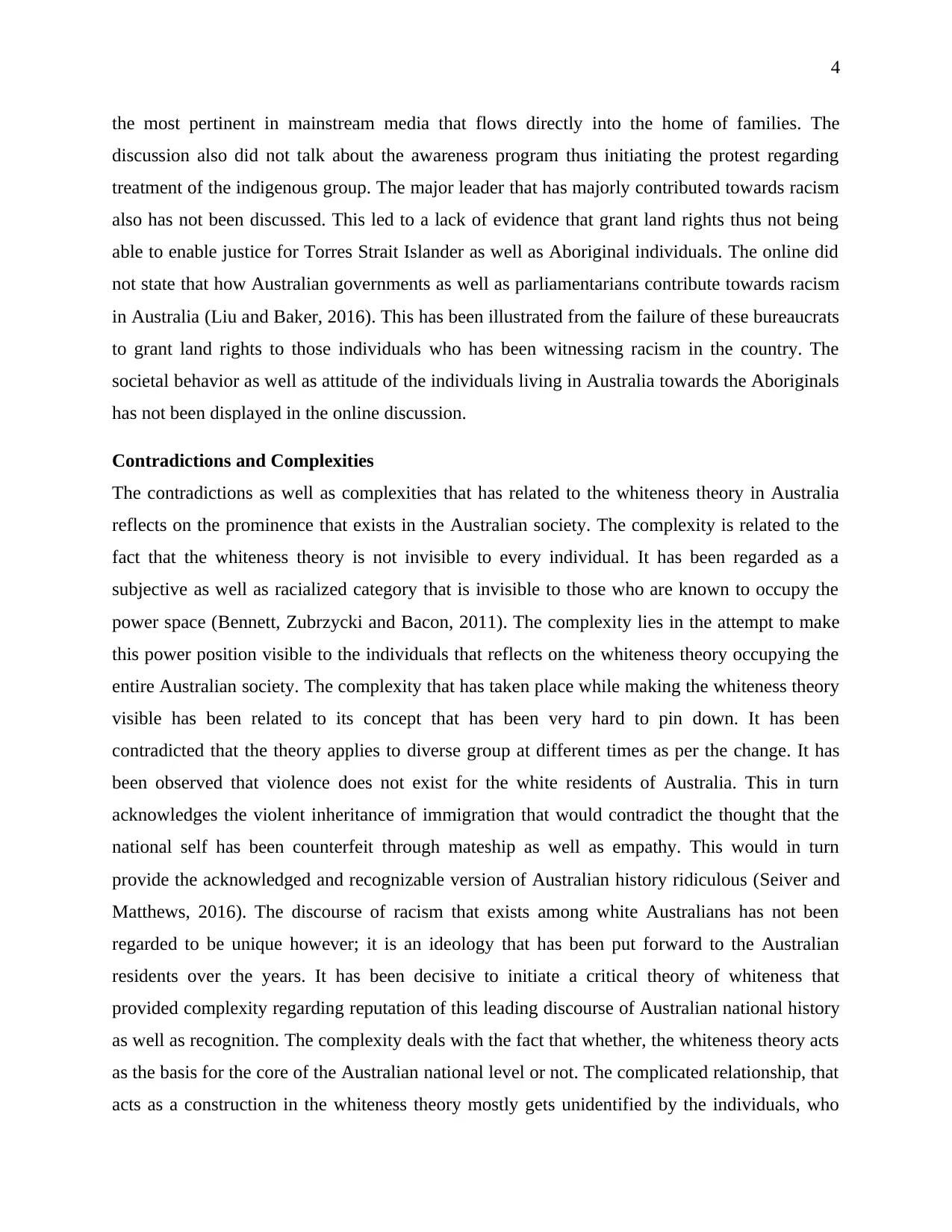
4
the most pertinent in mainstream media that flows directly into the home of families. The
discussion also did not talk about the awareness program thus initiating the protest regarding
treatment of the indigenous group. The major leader that has majorly contributed towards racism
also has not been discussed. This led to a lack of evidence that grant land rights thus not being
able to enable justice for Torres Strait Islander as well as Aboriginal individuals. The online did
not state that how Australian governments as well as parliamentarians contribute towards racism
in Australia (Liu and Baker, 2016). This has been illustrated from the failure of these bureaucrats
to grant land rights to those individuals who has been witnessing racism in the country. The
societal behavior as well as attitude of the individuals living in Australia towards the Aboriginals
has not been displayed in the online discussion.
Contradictions and Complexities
The contradictions as well as complexities that has related to the whiteness theory in Australia
reflects on the prominence that exists in the Australian society. The complexity is related to the
fact that the whiteness theory is not invisible to every individual. It has been regarded as a
subjective as well as racialized category that is invisible to those who are known to occupy the
power space (Bennett, Zubrzycki and Bacon, 2011). The complexity lies in the attempt to make
this power position visible to the individuals that reflects on the whiteness theory occupying the
entire Australian society. The complexity that has taken place while making the whiteness theory
visible has been related to its concept that has been very hard to pin down. It has been
contradicted that the theory applies to diverse group at different times as per the change. It has
been observed that violence does not exist for the white residents of Australia. This in turn
acknowledges the violent inheritance of immigration that would contradict the thought that the
national self has been counterfeit through mateship as well as empathy. This would in turn
provide the acknowledged and recognizable version of Australian history ridiculous (Seiver and
Matthews, 2016). The discourse of racism that exists among white Australians has not been
regarded to be unique however; it is an ideology that has been put forward to the Australian
residents over the years. It has been decisive to initiate a critical theory of whiteness that
provided complexity regarding reputation of this leading discourse of Australian national history
as well as recognition. The complexity deals with the fact that whether, the whiteness theory acts
as the basis for the core of the Australian national level or not. The complicated relationship, that
acts as a construction in the whiteness theory mostly gets unidentified by the individuals, who
the most pertinent in mainstream media that flows directly into the home of families. The
discussion also did not talk about the awareness program thus initiating the protest regarding
treatment of the indigenous group. The major leader that has majorly contributed towards racism
also has not been discussed. This led to a lack of evidence that grant land rights thus not being
able to enable justice for Torres Strait Islander as well as Aboriginal individuals. The online did
not state that how Australian governments as well as parliamentarians contribute towards racism
in Australia (Liu and Baker, 2016). This has been illustrated from the failure of these bureaucrats
to grant land rights to those individuals who has been witnessing racism in the country. The
societal behavior as well as attitude of the individuals living in Australia towards the Aboriginals
has not been displayed in the online discussion.
Contradictions and Complexities
The contradictions as well as complexities that has related to the whiteness theory in Australia
reflects on the prominence that exists in the Australian society. The complexity is related to the
fact that the whiteness theory is not invisible to every individual. It has been regarded as a
subjective as well as racialized category that is invisible to those who are known to occupy the
power space (Bennett, Zubrzycki and Bacon, 2011). The complexity lies in the attempt to make
this power position visible to the individuals that reflects on the whiteness theory occupying the
entire Australian society. The complexity that has taken place while making the whiteness theory
visible has been related to its concept that has been very hard to pin down. It has been
contradicted that the theory applies to diverse group at different times as per the change. It has
been observed that violence does not exist for the white residents of Australia. This in turn
acknowledges the violent inheritance of immigration that would contradict the thought that the
national self has been counterfeit through mateship as well as empathy. This would in turn
provide the acknowledged and recognizable version of Australian history ridiculous (Seiver and
Matthews, 2016). The discourse of racism that exists among white Australians has not been
regarded to be unique however; it is an ideology that has been put forward to the Australian
residents over the years. It has been decisive to initiate a critical theory of whiteness that
provided complexity regarding reputation of this leading discourse of Australian national history
as well as recognition. The complexity deals with the fact that whether, the whiteness theory acts
as the basis for the core of the Australian national level or not. The complicated relationship, that
acts as a construction in the whiteness theory mostly gets unidentified by the individuals, who
Paraphrase This Document
Need a fresh take? Get an instant paraphrase of this document with our AI Paraphraser
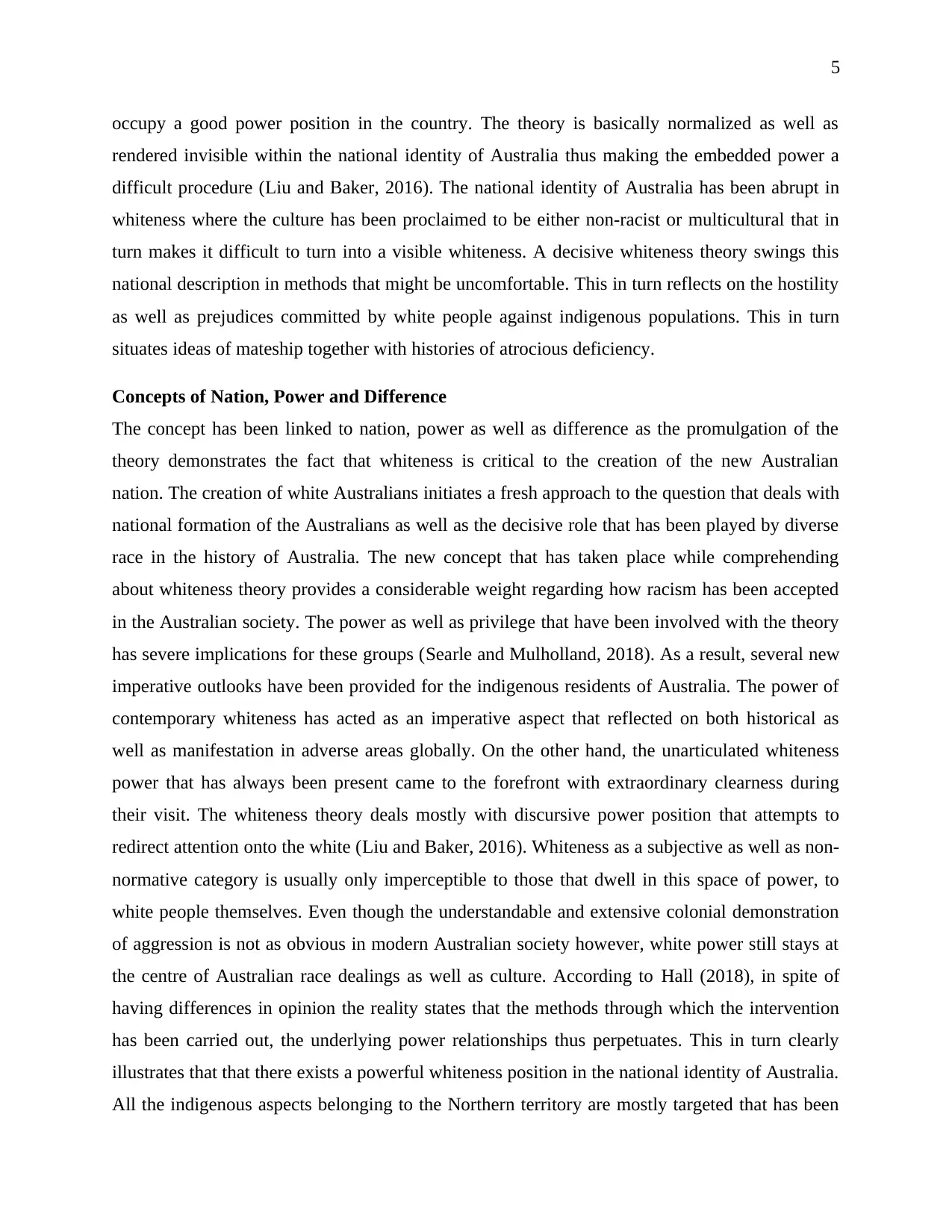
5
occupy a good power position in the country. The theory is basically normalized as well as
rendered invisible within the national identity of Australia thus making the embedded power a
difficult procedure (Liu and Baker, 2016). The national identity of Australia has been abrupt in
whiteness where the culture has been proclaimed to be either non-racist or multicultural that in
turn makes it difficult to turn into a visible whiteness. A decisive whiteness theory swings this
national description in methods that might be uncomfortable. This in turn reflects on the hostility
as well as prejudices committed by white people against indigenous populations. This in turn
situates ideas of mateship together with histories of atrocious deficiency.
Concepts of Nation, Power and Difference
The concept has been linked to nation, power as well as difference as the promulgation of the
theory demonstrates the fact that whiteness is critical to the creation of the new Australian
nation. The creation of white Australians initiates a fresh approach to the question that deals with
national formation of the Australians as well as the decisive role that has been played by diverse
race in the history of Australia. The new concept that has taken place while comprehending
about whiteness theory provides a considerable weight regarding how racism has been accepted
in the Australian society. The power as well as privilege that have been involved with the theory
has severe implications for these groups (Searle and Mulholland, 2018). As a result, several new
imperative outlooks have been provided for the indigenous residents of Australia. The power of
contemporary whiteness has acted as an imperative aspect that reflected on both historical as
well as manifestation in adverse areas globally. On the other hand, the unarticulated whiteness
power that has always been present came to the forefront with extraordinary clearness during
their visit. The whiteness theory deals mostly with discursive power position that attempts to
redirect attention onto the white (Liu and Baker, 2016). Whiteness as a subjective as well as non-
normative category is usually only imperceptible to those that dwell in this space of power, to
white people themselves. Even though the understandable and extensive colonial demonstration
of aggression is not as obvious in modern Australian society however, white power still stays at
the centre of Australian race dealings as well as culture. According to Hall (2018), in spite of
having differences in opinion the reality states that the methods through which the intervention
has been carried out, the underlying power relationships thus perpetuates. This in turn clearly
illustrates that that there exists a powerful whiteness position in the national identity of Australia.
All the indigenous aspects belonging to the Northern territory are mostly targeted that has been
occupy a good power position in the country. The theory is basically normalized as well as
rendered invisible within the national identity of Australia thus making the embedded power a
difficult procedure (Liu and Baker, 2016). The national identity of Australia has been abrupt in
whiteness where the culture has been proclaimed to be either non-racist or multicultural that in
turn makes it difficult to turn into a visible whiteness. A decisive whiteness theory swings this
national description in methods that might be uncomfortable. This in turn reflects on the hostility
as well as prejudices committed by white people against indigenous populations. This in turn
situates ideas of mateship together with histories of atrocious deficiency.
Concepts of Nation, Power and Difference
The concept has been linked to nation, power as well as difference as the promulgation of the
theory demonstrates the fact that whiteness is critical to the creation of the new Australian
nation. The creation of white Australians initiates a fresh approach to the question that deals with
national formation of the Australians as well as the decisive role that has been played by diverse
race in the history of Australia. The new concept that has taken place while comprehending
about whiteness theory provides a considerable weight regarding how racism has been accepted
in the Australian society. The power as well as privilege that have been involved with the theory
has severe implications for these groups (Searle and Mulholland, 2018). As a result, several new
imperative outlooks have been provided for the indigenous residents of Australia. The power of
contemporary whiteness has acted as an imperative aspect that reflected on both historical as
well as manifestation in adverse areas globally. On the other hand, the unarticulated whiteness
power that has always been present came to the forefront with extraordinary clearness during
their visit. The whiteness theory deals mostly with discursive power position that attempts to
redirect attention onto the white (Liu and Baker, 2016). Whiteness as a subjective as well as non-
normative category is usually only imperceptible to those that dwell in this space of power, to
white people themselves. Even though the understandable and extensive colonial demonstration
of aggression is not as obvious in modern Australian society however, white power still stays at
the centre of Australian race dealings as well as culture. According to Hall (2018), in spite of
having differences in opinion the reality states that the methods through which the intervention
has been carried out, the underlying power relationships thus perpetuates. This in turn clearly
illustrates that that there exists a powerful whiteness position in the national identity of Australia.
All the indigenous aspects belonging to the Northern territory are mostly targeted that has been
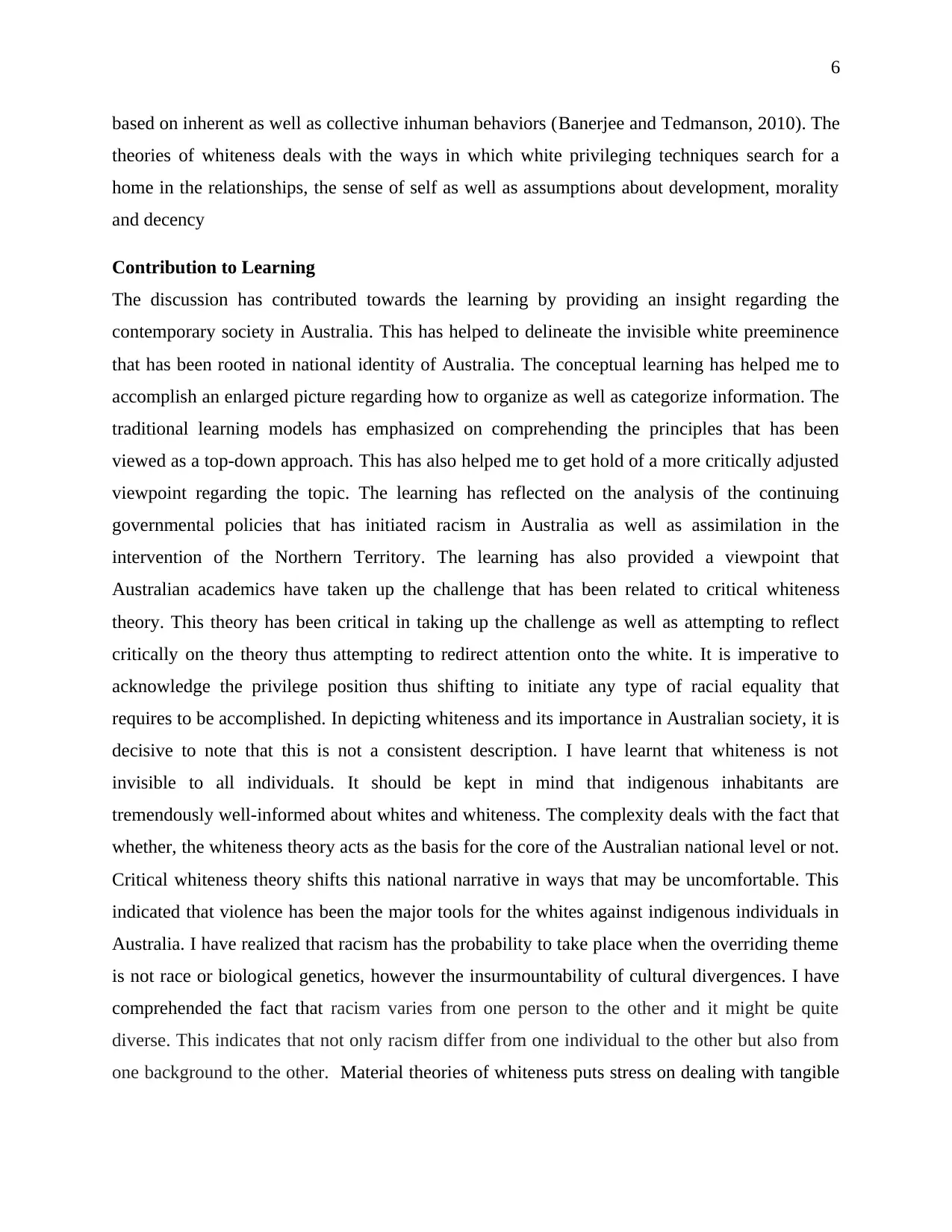
6
based on inherent as well as collective inhuman behaviors (Banerjee and Tedmanson, 2010). The
theories of whiteness deals with the ways in which white privileging techniques search for a
home in the relationships, the sense of self as well as assumptions about development, morality
and decency
Contribution to Learning
The discussion has contributed towards the learning by providing an insight regarding the
contemporary society in Australia. This has helped to delineate the invisible white preeminence
that has been rooted in national identity of Australia. The conceptual learning has helped me to
accomplish an enlarged picture regarding how to organize as well as categorize information. The
traditional learning models has emphasized on comprehending the principles that has been
viewed as a top-down approach. This has also helped me to get hold of a more critically adjusted
viewpoint regarding the topic. The learning has reflected on the analysis of the continuing
governmental policies that has initiated racism in Australia as well as assimilation in the
intervention of the Northern Territory. The learning has also provided a viewpoint that
Australian academics have taken up the challenge that has been related to critical whiteness
theory. This theory has been critical in taking up the challenge as well as attempting to reflect
critically on the theory thus attempting to redirect attention onto the white. It is imperative to
acknowledge the privilege position thus shifting to initiate any type of racial equality that
requires to be accomplished. In depicting whiteness and its importance in Australian society, it is
decisive to note that this is not a consistent description. I have learnt that whiteness is not
invisible to all individuals. It should be kept in mind that indigenous inhabitants are
tremendously well-informed about whites and whiteness. The complexity deals with the fact that
whether, the whiteness theory acts as the basis for the core of the Australian national level or not.
Critical whiteness theory shifts this national narrative in ways that may be uncomfortable. This
indicated that violence has been the major tools for the whites against indigenous individuals in
Australia. I have realized that racism has the probability to take place when the overriding theme
is not race or biological genetics, however the insurmountability of cultural divergences. I have
comprehended the fact that racism varies from one person to the other and it might be quite
diverse. This indicates that not only racism differ from one individual to the other but also from
one background to the other. Material theories of whiteness puts stress on dealing with tangible
based on inherent as well as collective inhuman behaviors (Banerjee and Tedmanson, 2010). The
theories of whiteness deals with the ways in which white privileging techniques search for a
home in the relationships, the sense of self as well as assumptions about development, morality
and decency
Contribution to Learning
The discussion has contributed towards the learning by providing an insight regarding the
contemporary society in Australia. This has helped to delineate the invisible white preeminence
that has been rooted in national identity of Australia. The conceptual learning has helped me to
accomplish an enlarged picture regarding how to organize as well as categorize information. The
traditional learning models has emphasized on comprehending the principles that has been
viewed as a top-down approach. This has also helped me to get hold of a more critically adjusted
viewpoint regarding the topic. The learning has reflected on the analysis of the continuing
governmental policies that has initiated racism in Australia as well as assimilation in the
intervention of the Northern Territory. The learning has also provided a viewpoint that
Australian academics have taken up the challenge that has been related to critical whiteness
theory. This theory has been critical in taking up the challenge as well as attempting to reflect
critically on the theory thus attempting to redirect attention onto the white. It is imperative to
acknowledge the privilege position thus shifting to initiate any type of racial equality that
requires to be accomplished. In depicting whiteness and its importance in Australian society, it is
decisive to note that this is not a consistent description. I have learnt that whiteness is not
invisible to all individuals. It should be kept in mind that indigenous inhabitants are
tremendously well-informed about whites and whiteness. The complexity deals with the fact that
whether, the whiteness theory acts as the basis for the core of the Australian national level or not.
Critical whiteness theory shifts this national narrative in ways that may be uncomfortable. This
indicated that violence has been the major tools for the whites against indigenous individuals in
Australia. I have realized that racism has the probability to take place when the overriding theme
is not race or biological genetics, however the insurmountability of cultural divergences. I have
comprehended the fact that racism varies from one person to the other and it might be quite
diverse. This indicates that not only racism differ from one individual to the other but also from
one background to the other. Material theories of whiteness puts stress on dealing with tangible
⊘ This is a preview!⊘
Do you want full access?
Subscribe today to unlock all pages.

Trusted by 1+ million students worldwide
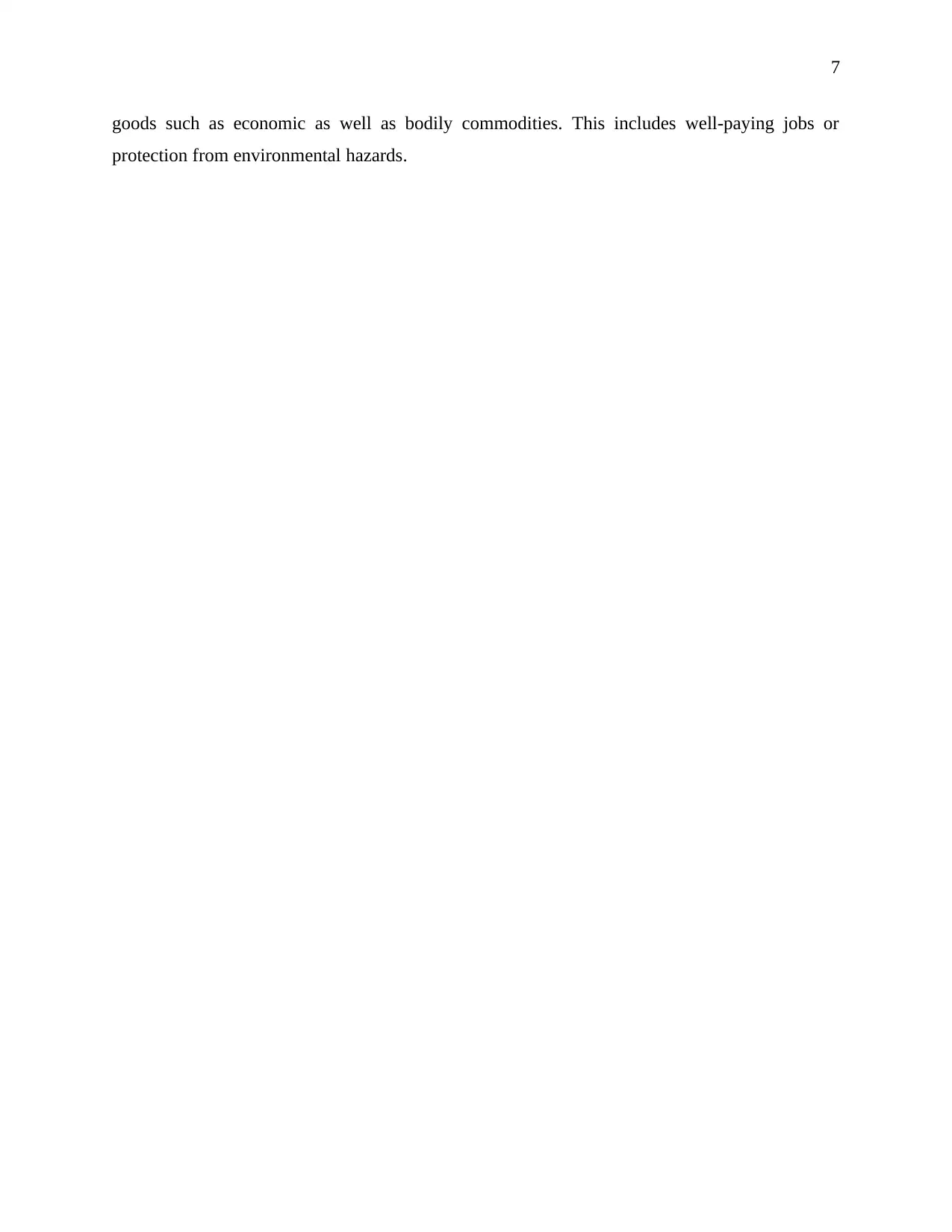
7
goods such as economic as well as bodily commodities. This includes well-paying jobs or
protection from environmental hazards.
goods such as economic as well as bodily commodities. This includes well-paying jobs or
protection from environmental hazards.
Paraphrase This Document
Need a fresh take? Get an instant paraphrase of this document with our AI Paraphraser
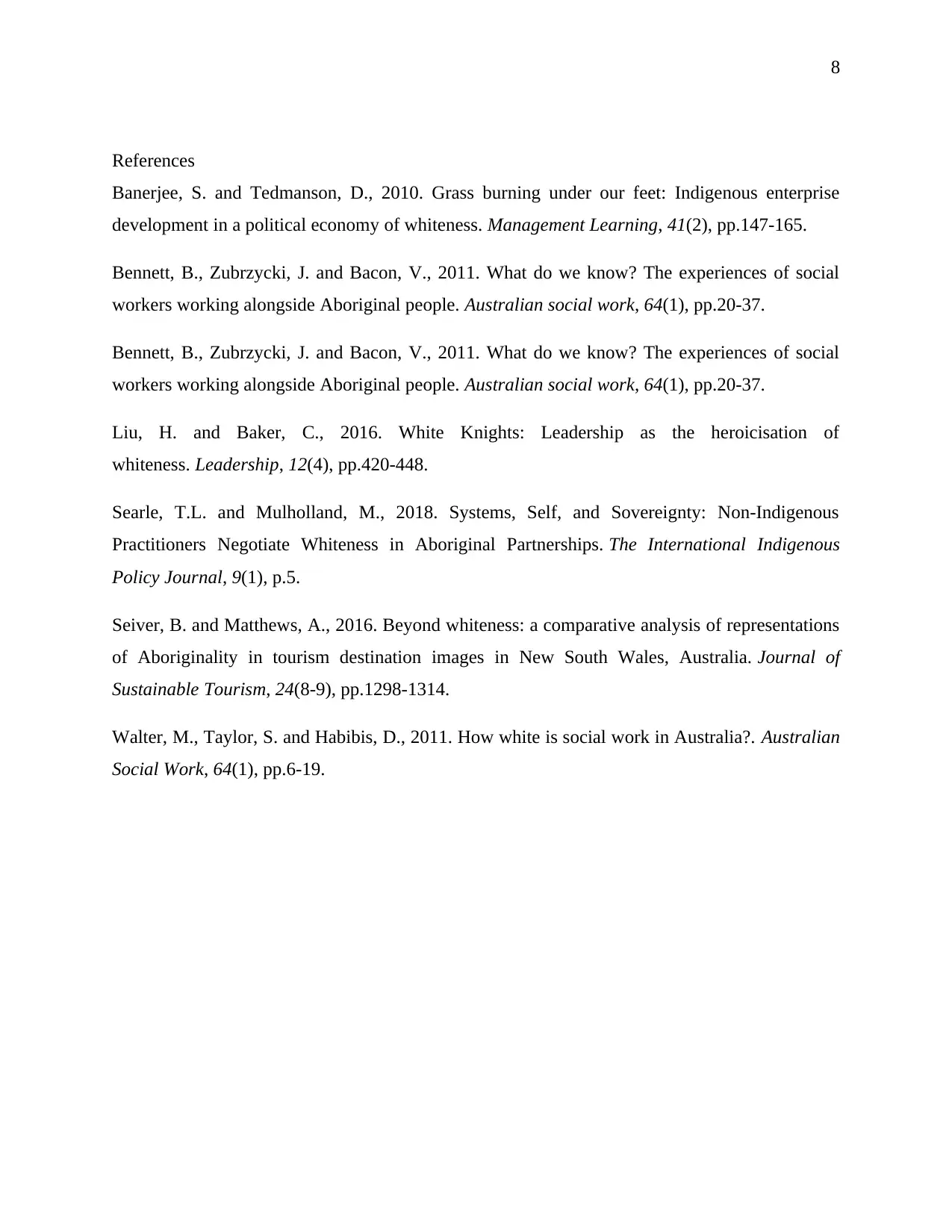
8
References
Banerjee, S. and Tedmanson, D., 2010. Grass burning under our feet: Indigenous enterprise
development in a political economy of whiteness. Management Learning, 41(2), pp.147-165.
Bennett, B., Zubrzycki, J. and Bacon, V., 2011. What do we know? The experiences of social
workers working alongside Aboriginal people. Australian social work, 64(1), pp.20-37.
Bennett, B., Zubrzycki, J. and Bacon, V., 2011. What do we know? The experiences of social
workers working alongside Aboriginal people. Australian social work, 64(1), pp.20-37.
Liu, H. and Baker, C., 2016. White Knights: Leadership as the heroicisation of
whiteness. Leadership, 12(4), pp.420-448.
Searle, T.L. and Mulholland, M., 2018. Systems, Self, and Sovereignty: Non-Indigenous
Practitioners Negotiate Whiteness in Aboriginal Partnerships. The International Indigenous
Policy Journal, 9(1), p.5.
Seiver, B. and Matthews, A., 2016. Beyond whiteness: a comparative analysis of representations
of Aboriginality in tourism destination images in New South Wales, Australia. Journal of
Sustainable Tourism, 24(8-9), pp.1298-1314.
Walter, M., Taylor, S. and Habibis, D., 2011. How white is social work in Australia?. Australian
Social Work, 64(1), pp.6-19.
References
Banerjee, S. and Tedmanson, D., 2010. Grass burning under our feet: Indigenous enterprise
development in a political economy of whiteness. Management Learning, 41(2), pp.147-165.
Bennett, B., Zubrzycki, J. and Bacon, V., 2011. What do we know? The experiences of social
workers working alongside Aboriginal people. Australian social work, 64(1), pp.20-37.
Bennett, B., Zubrzycki, J. and Bacon, V., 2011. What do we know? The experiences of social
workers working alongside Aboriginal people. Australian social work, 64(1), pp.20-37.
Liu, H. and Baker, C., 2016. White Knights: Leadership as the heroicisation of
whiteness. Leadership, 12(4), pp.420-448.
Searle, T.L. and Mulholland, M., 2018. Systems, Self, and Sovereignty: Non-Indigenous
Practitioners Negotiate Whiteness in Aboriginal Partnerships. The International Indigenous
Policy Journal, 9(1), p.5.
Seiver, B. and Matthews, A., 2016. Beyond whiteness: a comparative analysis of representations
of Aboriginality in tourism destination images in New South Wales, Australia. Journal of
Sustainable Tourism, 24(8-9), pp.1298-1314.
Walter, M., Taylor, S. and Habibis, D., 2011. How white is social work in Australia?. Australian
Social Work, 64(1), pp.6-19.
1 out of 8
Related Documents
Your All-in-One AI-Powered Toolkit for Academic Success.
+13062052269
info@desklib.com
Available 24*7 on WhatsApp / Email
![[object Object]](/_next/static/media/star-bottom.7253800d.svg)
Unlock your academic potential
Copyright © 2020–2025 A2Z Services. All Rights Reserved. Developed and managed by ZUCOL.





